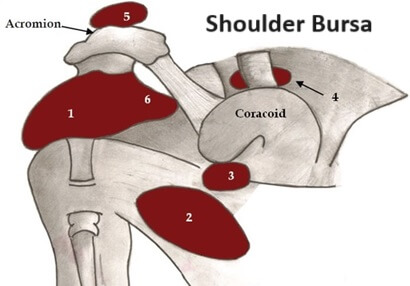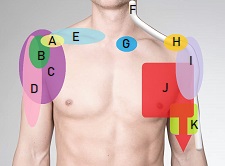- Home
- Common Shoulder Problems
- Bursitis
Shoulder Bursitis
Written By: Chloe Wilson BSc (Hons) Physiotherapy
Reviewed By: SPE Medical Review Board
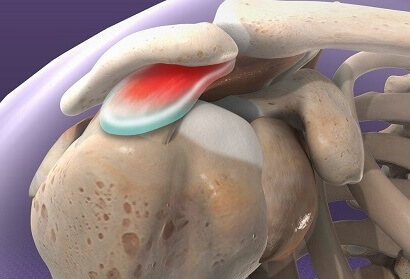
Shoulder bursitis is a common cause of shoulder and upper arm pain.
Bursitis develops when one of the bursa, a small fluid-filled sac, becomes irritated and inflamed.
There are a number of different bursa around the shoulder that may be affected, but the most common type of shoulder bursitis is subacromial bursitis.
Pain from shoulder bursitis tends to develop gradually over time and may limit movements where you lift your arm above your head or behind your neck or back. There may even be an obvious shoulder lump.
When treated promptly and effectively, symptoms will usually resolve within a few weeks, but left untreated, symptoms gradually get worse and secondary problems can develop. Here, we will look at the common causes, symptoms and treatment options for shoulder bursitis.
What are The Shoulder Bursa?
The shoulder bursa provide cushioning and a smooth surface allowing the tissues to glide freely and fully as you move without any friction. A bursa is a smooth sac that contains synovial cells that produce lubricating fluid. There are over 150 bursa located throughout your body which sit between muscles, tendons and/or bones.
There are a number of shoulder bursa located around the joint as shown in the diagram including the:
- Subacromial bursa
- Subscapular bursa
- Subcoracoid bursa
- Coracoclavicular bursa
- Supraacromial bursa
- Subdeltoid bursa
Inflammation of any of these shoulder bursa may cause shoulder and arm pain and, in some cases, a lump on the shoulder.
The most common type of shoulder bursitis is subacromial bursitis which is often linked with shoulder impingement syndrome. There are other bursa located around the shoulder blade and inflammation of these is known as scapulothoracic bursitis. You can also get bursitis at the elbow, known as olecranon bursitis.
Causes of Shoulder Bursitis
The most common causes of shoulder bursitis are:
- Repetitive Friction: Repeated overhead movements such as racket sports, painting a ceiling, throwing and swimming can cause repeated micro-trauma to the bursa. This is the most common cause of shoulder bursitis
- Injury: A sudden injury such as a fall onto the shoulder, or landing on an outstretched hand can lead to bleeding and inflammation of the bursa
- Underlying Condition: Medical conditions such as rheumatoid arthritis, gout or a bacterial infection can cause bursitis shoulder
- Surrounding Structures: If the space surrounding the bursa is reduced, such as the subacromial space, more pressure is placed on the bursa and it gradually becomes inflamed. This can happen as a result of arthritis, poor posture, muscle imbalance or inflammation of other surrounding structures.
When a shoulder bursa gets irritated or injured, it responds by producing more synovial fluid in an attempt to protect itself and the surrounding tissues which leads to inflammation.
Whilst inflammation can develop in any of the bursae around the shoulder, the most common are subacromial bursitis at the front of the shoulder and scapulothoracic bursitis at back of the shoulder blade.
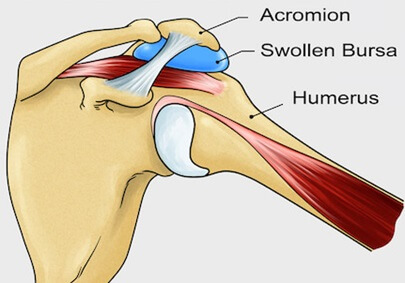
The subacromial bursa provides cushioning between the rotator cuff tendons and the acromion, the front part of the shoulder blade that forms a sort of bridge over the tendons, in what is known as the subacromial space.
Anytime you move your arm up the rotator cuff tendons are gliding through this space.
Anything which narrows the space leads to irritation in the bursa and the tendons themselves which leads to inflammation, pain and restricted motion.
Bursitis shoulder is rarely found in isolation but tends to co-exist with other shoulder problems such as shoulder impingement, supraspinatus tendonitis, biceps tendonitis and rotator cuff tears.
Shoulder Bursitis Symptoms
Shoulder bursitis often produces a muddled picture of symptoms so it can be hard to diagnose, especially in the early stages. You should always see your doctor or physical therapist for a full assessment.
Shoulder bursitis symptoms may vary from person to person but usually include:
- Shoulder & Arm Pain
- Joint Stiffness
- Arm & Shoulder Weakness
- Signs of Infection
Let's find out more about these common symptoms of shoulder bursitis.
1. Shoulder Pain
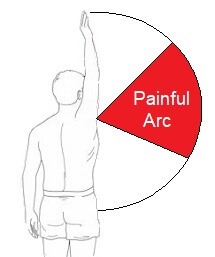
The most common symptom of shoulder bursitis is pain. In most cases, the pain develops gradually over time due to repeated friction over the bursa. It tends to be a low level aching pain that gets worse with activities where your arm is raised over your head.
Pain from bursitis of the shoulder is usually fairly localised over the problem area but over time, the pain may radiate down the arm, but usually not past the elbow. If shoulder bursitis was caused by a one-off injury, the pain will more likely be instant and more severe.
It can be extremely painful when any pressure goes through the shoulder with bursitis, making things like sleeping on your side very uncomfortable - people with shoulder bursitis often report that their sleep is frequently interrupted.
If there is inflammation of the supraspinatus tendon, known as supraspinatus tendonitis, as well as the bursa, you may have a painful arc where as you lift the arm up it starts to get painful, but once you have reached a certain height, the pain diminishes. This is due to how the pressure changes through the bursa as you move the arm.
2. Shoulder Stiffness
Shoulder movements may become limited with shoulder bursitis, particularly when reaching over head or behind your back/neck as the condition progresses. This tends to develop secondary to pain - it hurts to move the arm so you use it less.
This is fine in the short term, as you need to protect the bursa from further damage, but if it continues long term, the soft tissues aren't getting moved and stretched as they should so they start to tighten which further limits movement and creates and more pain. Physical Therapy is one of the best ways to avoid stiffness from bursitis of the shoulder developing, or treat it if it has.
3. Muscle Weakness
In time, if your shoulder bursitis pain is causing you to favour the arm, the shoulder muscles may lose some strength. This can cause further problems as the weakness leads to subtle changes to the way the shoulder and shoulder blade move which can lead to further irritation.
Rotator cuff strengthening exercises can really help combat this weakness.
4. Signs of Infection
Septic bursitis, where there is an infection in the bursa, usually bacterial, will result in you feeling unwell with a high temperature, and the shoulder is often red and warm. There may be a noticeable soft lump on your shoulder. If you suspect you have an infection, you must see your doctor immediately as the infection will need to be treated with antibiotics.
Sometimes when bursa become inflamed, particularly with elbow or knee bursitis, it gets to a point where there is noticeable swelling, like a small squashy orange, but this is uncommon in shoulder bursitis.
Shoulder Bursitis Treatment
Shoulder bursitis treatment aims to reduce pain and inflammation, prevent and correct any weakness and decreased movement at the shoulder, prevent secondary problems developing such as shoulder impingement, and get you back to your usual activities.
#CommissionsEarned from Amazon on qualifying purchases
There are a number of different shoulder bursitis treatment options:
1. Rest
It is important to avoid activities which aggravate your shoulder bursitis, such as overhead movements to give the bursa a chance to heal. If you keep pushing on into the pain, the friction over the bursa continues and the inflammation doesn’t get a chance to settle down and will gradually get worse.
2. Regular Ice Treatment
Applying ice, wrapped in a towel or a specially designed shoulder ice pack regularly to the shoulder can help to reduce pain and inflammation in the bursa. It should be used for 10-15 minutes at a time, with at least two hours between applications.
You can find out more about safe and effective ice treatment on our sister site
3. Medications
Your doctor may prescribe non-steroidal anti-inflammatory medication (NSAIDs) such as ibuprofen/Advil to help to reduce the pain and the swelling.
4. Aspiration
In some cases, your doctor may decide to drain fluid off the bursa to help reduce the swelling, especially if they are worried about infection. They will send the fluid off for testing to see if there is an infection which would require antibiotics. Aspiration is usually combined with a corticosteroid injection.
5. Physical Therapy
Physical therapy is a vital part of shoulder bursitis treatment, both to treat the condition and to prevent it from recurring.
A physical therapist will work on rehab program with you to address any areas of weakness, stiffness, instability and tightness as well as any postural problems to ensure you regain full movement and strength in the arm, and good stability around the shoulder blade all of which help to prevent the problem from recurring. Visit the rotator cuff exercises section for suitable exercises.
Some therapists may use ultrasound to help reduce inflammation and facilitate healing but the evidence is mixed.
6. Steroid Injections
Injections are one of the best ways to treat shoulder bursitis. A mix of local anaesthetic and corticosteroid solution are injected into the bursa to reduce pain and inflammation.
Ideally the injection should be done under ultrasound guidance to ensure delivery to the correct area as shown in the video here. You can see both the patient and the ultrasound view, and you can actually see the bursa inflate as the fluid is injected.
It is important to take it easy for the first few days following an injection and avoid heavy lifting. You can find out more about injections on our sister site.
7. Improve Posture
Thinking about your posture and making some simple changes to your desk set up and how you use screens is an important part of shoulder bursitis treatment and is crucial to stop it from coming back. If you are someone who spends a lot of time sitting in front of a computer, check out our posture advice on things you can do to help.
8. Bursectomy Surgery
It is very rare that shoulder bursitis requires surgery but if all other treatment options fail, the bursa can be surgically removed through keyhole surgery. This is often combined with a subacromial decompression to make more space for the soft tissues.
Recovery & Prevention
People usually make a full recovery from shoulder bursitis but it may take a few weeks or months depending on the severity and any associated conditions.
Rotator cuff strengthening exercises, shoulder stability exercises focusing on the shoulder blade, and postural re-education are some of the best ways to reduce the friction going through the bursa thus preventing shoulder bursitis from recurring.
What Else Can Help?
Shoulder bursitis is often accompanied by other problems such as rotator cuff tears and shoulder impingement syndrome in which case they will also need to be addressed.
There are lots of other causes of lumps and bumps around the shoulder so if bursitis of the shoulder isn't sounding like your problem, check out the Shoulder Lumps article or the Lump On Collarbone article.
If shoulder bursitis doesn't sound quite like your problem, check out the shoulder pain diagnosis section or take a look at our diagnosis charts to find out what's wrong.
You may also be interested in the following articles:
- Common Shoulder Problems
- Front Shoulder Pain
- Pain Lifting Arm
- Shoulder Pain At Night
- Burning Shoulder Pain
- Subacromial Bursitis
Related Articles
Page Last Updated: November 5th, 2024
Next Review Due: November 5th, 2026
